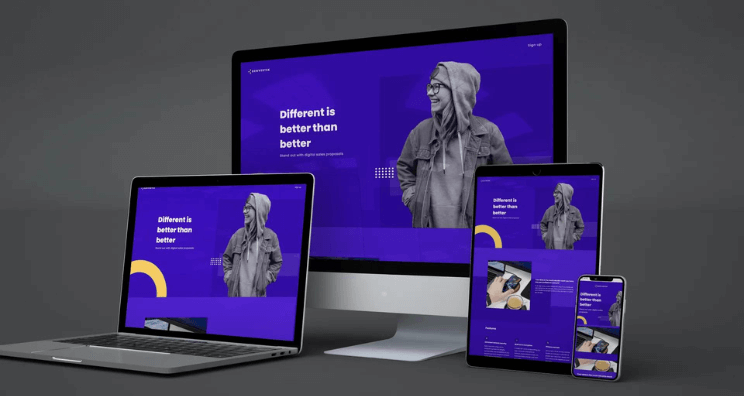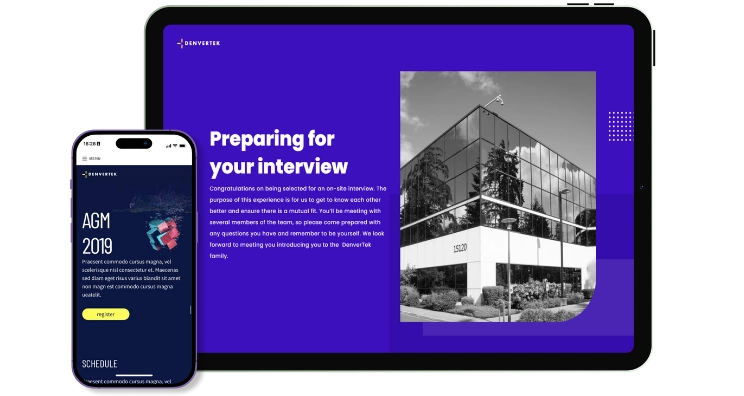Microsites are mini websites. Why do you need them?
Unlike traditional websites they’re great for one-off purposes and many organizations are beginning to use microsites as replacements for static documents. They have a range of use cases in areas like sales, marketing, learning and recruitment.
The microsite revolution is here to stay. The content experience platforms on which they’re often built have made it possible for content producers to roll out much more exciting assets than PDFs for important tasks where first impressions count, like pitching services or preparing personalized job offers.
The best microsites are referred to as content experiences. These are living, breathing websites — in miniature. They can be updated in real time and feature a range of embedded video and audio resources.
Microsites bridge the gap between how most of us access the internet and how many of us send resources to colleagues.
Making the case for microsites in your organization
Content experience platforms and website builders make rolling out microsites incredibly easy.
Users don’t need to know anything about web development to create or duplicate them. For many organizations, this means that microsites can replace standard documents once the right workflow is established. The rich multimedia often makes microsites far more impactful.
Nevertheless, getting from A (“Let’s send over a Word document for this client!”) to B (“Let’s prepare a microsite for them!”), isn’t always simple in large organizations where workflows may need to be carefully documented and stakeholders may number in the thousands.
Add potentially complicating factors of distributed teams and remote work and making the move forward becomes even more difficult for many companies to pull off.
Then there’s simple inertia. PDFs and Powerpoint presentations — longtime staples of the corporate world — have been around for what feels like an eternity. Most of us have been working with them for years which makes them feel reassuringly familiar.
The idea of sending out a mini website for a one off use on the other hand can seem disruptive. But disruption can be incredibly productive and lead to growth.
To make the case for microsites, find relevant examples to show your team so you can follow the old maxim of ‘show, don’t tell’, and demonstrate how engaging they can be.
Making the switch to microsites

While we recommend that those thinking of making the switchover prepare a business transformation plan to guide the transition, we recognize that moving to a microsite-only model can take time.
Just as there are many uses for microsites, there are plenty of ways to go about the process of integrating microsites into your organization.
Some will favor an “all-in” approach in which the team moves over to microsites immediately. Small, agile startups are often in the enviable position to pull off this type of change. For other teams a more gradual, hybrid approach may be more realistic.
As with any large change, a business transformation process is advisable. Some of the elements to include in the plan are:
- Assigning a project owner to spearhead the transition
- Breaking down the migration into manageable milestones
- Ensuring team members receive training on the new way of working and the platform
How microsites relate to your existing technologies
Microsites and PDFs aren’t sworn enemies. PDFs still have their place – legal documentation, for example. Microsites shouldn’t be thought of as a replacement for your company’s main site, either. They supplement your existing capabilities.
The following resources can be used by those that are looking for “stopgap” ways to move from a document-heavy approach to one that embraces the potential of richer online content experiences.
Here’s how to think about the relationship between microsites and your main site:
The company website
Company websites make it easy for prospective customers to find basic information about your company including what you do, who is on your team, and how to contact you.
How are microsites different?
Many companies use microsites to send personalized information that would otherwise be sent using Word documents, PDFs, or other static documents.
Why do they do this? Because microsite platforms like Zoomforth support the creation of password-protected and deindexed sites. This means that the microsites will not be indexed by search engines like Google and can only be viewed by those with a password or who can path through a federated login (we’ll cover security again later).
Clearly, companies would generally not want to post privileged or confidential information intended only for a specific audience on the company website. These microsites aren’t intended to be found by just anyone browsing the Internet with a search engine, hence the deindexing. Information for the public at large should be shared on the main website.
Despite this, microsites sometimes include information available to the general public. Many microsites contain a mixture of both types of content. For instance, a team sending a microsite to bid on a project might include the outline of specific services for the client on one page of the microsite (private information) and the company history on another (public information).
This second type of content, which is non-confidential and suitable for public access, could just as easily be posted on a company website. In fact, posting it to a website, keeping that resource updated, and then updating the microsite templates might make a lot more sense for some companies.
Using a company website in conjunction with microsites can also be a good move for organizations wishing to employ a stopgap approach or that already have a lot of good information on their websites.
The advantages of site-based communication
There are advantages to posting any information — including general company information — online rather than including it in email attachments and other static documents that apply to both microsites and standard pages.
- Users don’t need to download anything in order to access your information. They just need a web browser.
- Authors are able to control the look and feel of the content. Most content management systems make it easy to preview how content will look on desktop or mobile devices.
- Almost all users should be able to access the content. Not every cell phone user has a document reader installed on their phone. By contrast, virtually all of them have a browser installed on their phone.
- Updating the information is as easy as editing a live document. Changes can be pushed out in real time. By contrast, once users have sent a document by email, there is generally no way to recall or update it.
Advantages of microsites over static documents
Organizations might choose to continue to use static documents — like Microsoft Word files — to communicate certain information alongside microsites.
Just like company websites, this doesn’t need to be an “all or nothing” approach. For instance, content experience platforms such as Zoomforth make it easy for authors to include documents in microsites.
The difference is that Zoomforth makes it easy to present PDFs in the most attractive manner. Additionally adding PDFs as embedded content in live websites means that users don’t have to download files in order to access your document-locked content.

Why use a microsite platform?
Let’s recap what we’ve covered for a moment.
Many organizations benefit from making the transition from static document-centric workflows over to microsites.
Additionally, both evergreen content on company websites and static documents can be used in conjunction with microsites so users needn’t feel hemmed in by an ‘all or nothing’ approach.
Hybrid models serve many users well, particularly during transition periods. For instance, static documents can be integrated into microsites as download objects.
While these are important factors to consider, content experience platforms retain some distinct advantages over older communications technologies. These advantages apply equally to large businesses and smaller ones.
Let’s review these now:
Interactive
From a communications standpoint, static files offer little in the way of interactivity. Take a Word document, for instance. They’re designed to be read. There’s nothing for users to do other than scroll through the document to find the part that (may) interest them the most.
On your average website, by way of contrast, there’s a lot that users can do. Users can use the navigation menu to jump to another page. They can access newsfeeds and infographics or start playing a video. Interactive elements like these are great ways to increase visitor engagement.
When users have options presented to them, they tend to become more engaged in the information they’re consuming. Interaction is the difference between a one dimensional wall of text and something truly worthy of being called a content experience.
Tracking
If you’re sending out Word documents, then you’re almost certainly in the dark about how recipients are engaging with the information you send over. Compare this to analytics tracking on a website and the differences seem stark.
You may know that the user downloaded your email attachment (if you’re using download tracking) but you have no idea how long they spent on the document, what parts of the content they engaged with, and where they stopped reading in.
The good news — for anybody familiar with website analytics — is that content experience platforms offer exactly the same kind of in-depth metrics that webmasters have been using for years. With the added advantage that microsites are typically specific to one audience.
This means that users don’t have to sift through a mountain of website data to understand exactly how a specific audience interacted with the content. Compared to sending out static documents by email, the difference, in terms of the volume of tracking information provided, is like night and day.
Secure
Even though sending information by email can seem more secure than putting it online, in some aspects, this isn’t necessarily the case.
For instance, what would happen if your email recipient were to forward your attachment to his personal email address and from there to hundreds of unauthorized contacts? The result could be a mass leaking of sensitive company information. Worse, the company wouldn’t be able to access the send log.
By contrast, with Zoomforth, security is carefully implemented through the various ways in which microsites can be secured and shielded from public access. Zoomforth supports the following methods for securing microsites
- Basic password protection
- Multifactor authentication (MFA): users will be prompted for a second token as well as a password
- SAML identification. Visitors can sign in through a single sign in portal
- Email-based one time password (OTP) authentication: access can be limited to a series of approved email addresses. Alternatively, every user at a domain can be granted access. For instance, access can be granted to all emails @acme.com. This is great for large organizations that may wish to restrict access to an internal microsite to only employees of the company.
Microsite, website or static document?
Microsites and content experience platforms have made it easy to share personalized information through miniature websites rather than by exchanging documents.
Content experiences are more immersive than static documents. They can be updated continuously and secured through a variety of means. They’re also trackable allowing authors far more insight into how audiences are engaging with them.
Nevertheless, many organizations seeking to use this technology for sales quoting, hiring or other use-cases would be best to favor a hybrid approach. Static documents can be embedded into microsites and evergreen content can be maintained and updated on websites and periodically updated in microsite templates.
Contact Zoomforth to learn more about how your organization can begin to make the transition.



